On 7 March 2010 it is a 100 years since the Dutch flag is hoisted up by Captain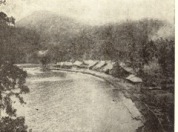 F.J.P. Sachse on the north coast of New Guinea. Sache is the commander of the Northern Detachment, one of three military exploration detachments that set out to explore New Guinea in the early part of the 20th century. The Northern Detachment consists of Captain Sache and three other officers, 80 Indonesian soldiers, 60 porters as well as labourers, servants, women and children (270 people in total). Five months earlier, they all boarded the carrier ‘Van Den Bosch’. Shortly after landing, they build a base camp along the beach of Humboldt Bay.
F.J.P. Sachse on the north coast of New Guinea. Sache is the commander of the Northern Detachment, one of three military exploration detachments that set out to explore New Guinea in the early part of the 20th century. The Northern Detachment consists of Captain Sache and three other officers, 80 Indonesian soldiers, 60 porters as well as labourers, servants, women and children (270 people in total). Five months earlier, they all boarded the carrier ‘Van Den Bosch’. Shortly after landing, they build a base camp along the beach of Humboldt Bay. 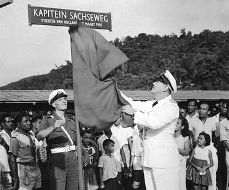 The official ceremony in 1910, 400 years after the discovery of New Guinea, represents the actual foundation of Hollandia, now called Jayapura, the provincial capital of Papua in Indonesia.
The official ceremony in 1910, 400 years after the discovery of New Guinea, represents the actual foundation of Hollandia, now called Jayapura, the provincial capital of Papua in Indonesia.
The weather is bad on the day of the flag raising ceremony, but the mood among the officers of the Northern Detachment is excellent. There they stand around the flag pole in their clean tunics with shining buttons. The red, white and blue stripes of the Dutch flag is to fly over Hollandia for more than 50 years, up until it was handed over to Indonesia in 1962.
Content:
1. Land procured for a hundred guilders
2. Founding Hollandia
3. Hunting Birds of Paradise spurs trade and development
4. The first colonists arrive
5. Japanese take over Hollandia
6. The Allies strike back
7. The biggest booty of Japanese in the Pacific
8. Americans address infrastructure
9. NICA Governs liberated area
10. Massive distribution and rebuilding
11. The final years of Dutch Rule:1949-1962
12. The new regime Indonesia
13. Links
14. Source
1. New settlement procured for a hundred guilders
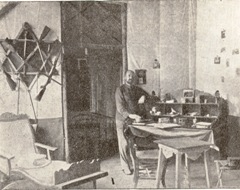 On 23 September 1909, four officers of the Northern Detachment are the first to step onto a launch from the ‘Van der Bosch’ in order to land and find a suitable place to build a new settlement. They will end up living here for the next two years, totally cut off from the rest of the world.
On 23 September 1909, four officers of the Northern Detachment are the first to step onto a launch from the ‘Van der Bosch’ in order to land and find a suitable place to build a new settlement. They will end up living here for the next two years, totally cut off from the rest of the world.
By noon, they reach a sandy strip of land in front of a swampy area with coconut palms. A stream, the Noebai with crystal clear water, which flows into the bay through a cutting visible in the hillside behind the swamp. This creek originates in the Cyclops Mountains further inland.
Captain Sache’s men have to cut down 40 coconut palms in order to create an open space. At the first blows of the axes scaring of the Birds of Paradise, some Papuans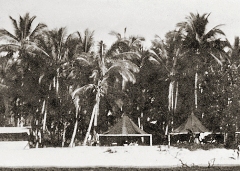 appear who argue that they own the palm trees. Sache immediately solves the problem by buying the swampy land from the chief of Tabati-Laoet village. He puts 40 Dutch quid, worth 2.50 guilders a piece, in the sand: one for each tree. The Papuans disappear into the jungle holding on to their shining treasure. The cutting can continue, a start has been made on constructing ‘Camp Hollandia’ at Humboldt Bay. It turns out to be an unhealthy spot. After only three months there are 40 cases of malaria and 30 suffering from Beriberi.
appear who argue that they own the palm trees. Sache immediately solves the problem by buying the swampy land from the chief of Tabati-Laoet village. He puts 40 Dutch quid, worth 2.50 guilders a piece, in the sand: one for each tree. The Papuans disappear into the jungle holding on to their shining treasure. The cutting can continue, a start has been made on constructing ‘Camp Hollandia’ at Humboldt Bay. It turns out to be an unhealthy spot. After only three months there are 40 cases of malaria and 30 suffering from Beriberi.
2. Founding Hollandia
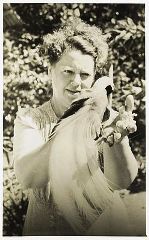 On 28 September, the construction of a permanent settlement begins, close to both the British and the German boundaries within the colony. At the 1895 Convention of The Hague, it was agreed that the border between Dutch and British New Guinea, was to run right through the centre of the island(along the 141st Meridian). The new settlement is therefore called ‘Hollandia’ to distinguish itself clearly from ‘Germania-Hoek’ (‘German Corner’), where the Germans have settled.
On 28 September, the construction of a permanent settlement begins, close to both the British and the German boundaries within the colony. At the 1895 Convention of The Hague, it was agreed that the border between Dutch and British New Guinea, was to run right through the centre of the island(along the 141st Meridian). The new settlement is therefore called ‘Hollandia’ to distinguish itself clearly from ‘Germania-Hoek’ (‘German Corner’), where the Germans have settled.
The Dutch East Indies Government has given Sachse a mandate to put an official border between these two regions onto the map within two years. Sache is to identify and investigate the possibility of changing the theoretical border along the 141st Meridian to a more practical, natural border.
The settlement develops into an administrative centre for northern New Guinea. In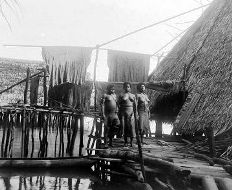 1902, an administrative post was established in Merauke in the south by the Dutch Government, to put a halt to any expansion by the English.
1902, an administrative post was established in Merauke in the south by the Dutch Government, to put a halt to any expansion by the English.
On 7 March 1910, less than a year after the arrival of the Northern Detachment, Hollandia is pronounced the capital of Dutch New Guinea.
3.Hunting Birds of Paradise spurs development
The settlement of Hollandia starts to flourish as a result of hunting for Birds of 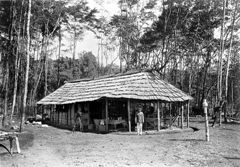 Paradise but this activity is of a temporary nature. After first licensing the hunt, it is banned in 1922 for most of this species, apart from the yellow variety. The merchants switch over to trading in tapa cloth from the Massai and Langwang tree, tripang(sea cucumber), Troca shells, Kopal resin and kopra (coconut). In 1930, coffee and cotton are added to the list of trade products.
Paradise but this activity is of a temporary nature. After first licensing the hunt, it is banned in 1922 for most of this species, apart from the yellow variety. The merchants switch over to trading in tapa cloth from the Massai and Langwang tree, tripang(sea cucumber), Troca shells, Kopal resin and kopra (coconut). In 1930, coffee and cotton are added to the list of trade products.
Around 1915, the newcomers have, despite very limited resources, managed to construct a 115-metre-long pier. It starts on the north side of the settlement and goes as far as Humboldt Bay. In 1916, the first church annex school is built by the Reverent J. Bijkerk.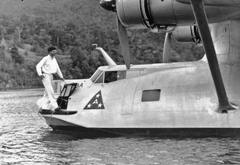
Then on 22 March 1923, Hollandia is hit by flooding from the River Nobai. The recently constructed bridge is swept away. The railings are later found some 70 Kilometres up the coast, in the German territory. The vicinity of Hollandia is also not completely safe because of local warfare. In 1925, there is a war between the Tbati and Enggros tribes and another one between the islets of Kayu Batu and Kayu Pulau.
The Dutch authorities also set up other posts around Hollandia. As early as 1909, the Dutch East Indies Government stationed its representative P.W.Windhouwer on the island of Metu Debi at jautefa Bay. He is assisted by two police guards. In 1920 an administrator is stationed at Lake Sentani. The post is initially at the spot where the Kajuba stream runs into the lake. In 1921 this post is first shifted to Dojo Baru but is moved to Ifar* in 1926, where it remains up until World War II. This post is not manned by Europeans but by personnel from the Dutch East Indies. A number of Europeans do however live in this hinterland of Hollandia. In 1928 a pathway is constructed to Ifar and extended to Kojabu.
*(Not to be confused with another post, the village of Ifar in the Cycloop Mountains).
4.The first? (More) colonists and further development
More colonists arrive in November of 1930. They settle, often under appalling 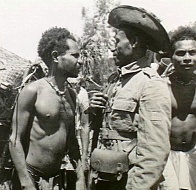 conditions, in villages they have to build themselves. Abel’s Place, Bijlslag, Juliana Village and Wever’s Place are examples of such settlements around Hollandia.
conditions, in villages they have to build themselves. Abel’s Place, Bijlslag, Juliana Village and Wever’s Place are examples of such settlements around Hollandia. The first doctor also lands in Hollandia around this time. And of course, a hospital is then the next step. It is ready by the end of 1931
As is to be expected, some Chinese stores appear. There are four of these by this time. In 1937, the primitive post office is improved and is fitted out with radio equipment for sending and receiving messages. Contact with the outside world is now much easier.
The police barracks, which houses about 30 policemen and their families, are refurbished. There is also a small prison that can take about 20 to 30 inmates. A mosque is built and Hollandia gets its first pasanggrahan( a government guest house). All of the buildings are simple wooden constructions covered with sirap(wooden tiles).
In April 1938 a welcome change disturbs the backwater that is Hollandia. After Richard Archibold’ sea plane discovers the Baliem Valley Area, several expeditions are organised to the region by the American Museum of Natural History. The Headquarter for the Third Archibold Expedition is built in the vicinity of Hollandia. They select a plateau on the north side of the town with a magnificent view over Humboldt Bay. A long wooden staircase has to be built to get up there. A new vessel arrives to explore the waterways in the region to the west. All this activity attracts attention and the population of Hollandia increases by some 200 inhabitants.
In the same period, a mission post is set up at Arso, a Papuan community 40 kilometres south of Hollandia.
Because of the pending threat of World War II, more and more patrol flights and sea planes come and go. And in 1939 an area is levelled at Ifar on Lake Sentani to start building an airport.
5. Japanese take over Hollandia
After the attack on Pearl Harbour on 8 December, the Netherlands joins forces with England and America by declaring war on Japan. Japanese warships arrive in
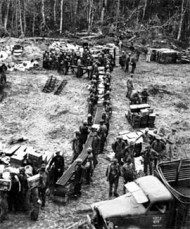 Humboldt Bay on 19 April 1942 and Hollandia is taken without resistance what so ever. The ships leave after only five days, along with the prisoners they have taken on board. It takes until 6 May for two more Japanese warships to arrive and this time marines are put ashore. In August an infantry is brought in to reinforce Japanese occupation. For the Papuans hard times are ahead. They have to both improve and construct new roads. At Lake Sentani, they create three airfields by manual labour. There are no diggers and scrapers to make life easier. Quite a bit of artillery is set up by them around Lake Sentani. Because of the sheltered bay and well-situated airfields, it becomes an important base for the Japanese.
Humboldt Bay on 19 April 1942 and Hollandia is taken without resistance what so ever. The ships leave after only five days, along with the prisoners they have taken on board. It takes until 6 May for two more Japanese warships to arrive and this time marines are put ashore. In August an infantry is brought in to reinforce Japanese occupation. For the Papuans hard times are ahead. They have to both improve and construct new roads. At Lake Sentani, they create three airfields by manual labour. There are no diggers and scrapers to make life easier. Quite a bit of artillery is set up by them around Lake Sentani. Because of the sheltered bay and well-situated airfields, it becomes an important base for the Japanese. 6. Allied Forces strike back
The invasion by the Allied Forces is preceded in 1944 by bombing on 30 and 31 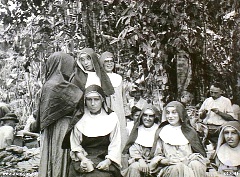 March and on 3, 5 and 12 April. The target is Sentani Airport and about 340 demolished Japanese planes are counted after the landing later in April. Another 50 have ended up in the nearby jungle after aerial combat or ‘dog fights’ as the English used to call these.
March and on 3, 5 and 12 April. The target is Sentani Airport and about 340 demolished Japanese planes are counted after the landing later in April. Another 50 have ended up in the nearby jungle after aerial combat or ‘dog fights’ as the English used to call these.
After the bombing, not a house was left in the pre-war area of Hollandia , known as ‘de kloof’ (‘the Gap’).
On 22 April, ten days after the bombing, two Allied Forces land in Hollandia: one at Tenah Merah Bay to the west, the other at Humboldt Bay. The Japanese in Hollandia are taken by surprise and do not really retaliate. They had expected the attack to be at Wewak or Hansai Bay. A large number take off into the jungle and 611 soldiers simply capitulate.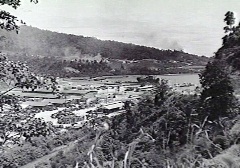
The American Commander Douglas MacArthur goes ashore himself on 24 April. In the afternoon of the same day, MacArthur and his men reach the airport near Lake Sentani. Here, they do encounter Japanese resistance. A pincer movement is used to move in the troops and surround the Japanese.
On 26 April first Cycloop airport and then Sentani airport are taken. Hollandia Airport is captured simultaneously by the troops that landed at Tenah Merah Bay.
During the invasion and the fighting around the airports, the Americans loose 152 men compared to 3300 on the Japanese side. The Japanese commander, General Inada and 7200 men attempt to escape overland from Lake Sentani to Sarmi-Wakde to the west. However because of illness and other hardships only 1000 men survive and years later Japanese soldiers still occasionally emerge from the jungle.
On 2 May 1944, the first official Dutch governmental post is created in Hollandia. The 'Hollandia operation’ is not terminated until June 6th as the area is first to be scoured to eliminate Japanese refugees.
7. The biggest booty of Japanese in the Pacific
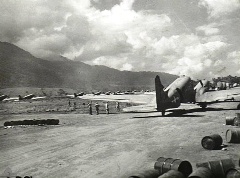 Four days after the capture, the first U.S. plane, a C-47 transport aircraft, lands on a heavily damaged Sentani airstrip.
Four days after the capture, the first U.S. plane, a C-47 transport aircraft, lands on a heavily damaged Sentani airstrip.
The largest Japanese booty of the entire war in the Pacific is found at the airports in New Guinea. Clothes are piled up high in the magazines and mountains of tinned food, as well as tons of quinine and the medical supplies are found here. There is also plenty of beer. Ammunition dumps are located in many places. They also free prisoners of war: 120 Sikhs and a total of 125 Roman Catholic priests and nuns of various nationalities.
8. Americans address infrastructure
With the arrival of the Americans, a massive number of activities are instigated. At 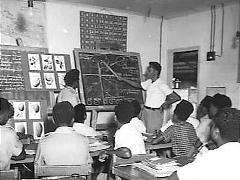 Hollandia Harbour the Americans set up the enormous Base G. At Tenah Merah they build a bunker for holding liquid fuels. Humboldt Bay becomes a temporary focal point for the ‘island hopping’-method used towards the Philippines and Japan.
Hollandia Harbour the Americans set up the enormous Base G. At Tenah Merah they build a bunker for holding liquid fuels. Humboldt Bay becomes a temporary focal point for the ‘island hopping’-method used towards the Philippines and Japan.
Within a few weeks, 11 docks are constructed, suitable for ships that weigh up to 10.000 tons. Dutch K.P.M ships (Dutch East Indies Trading ships used in the war effort) arrive among others with supplies. At times, there are more than 100 ships in the bay awaiting their turn.
After two months, the Americans have constructed a 100 km network of roads. After levelling the ground with giant bulldozers, the roads are made to short order. Three airstrips? Air ports? at Sentani are also repaired in a very short space of time and as a result 450 tons of supplies per day can be flown in from the American base at Finschhaven. (The two hundred metre long airstrip later becomes the airport for the KLM flights that come in on a weekly basis.)
MacArthur relocates his headquarters to Hollandia and stations himself just to the north of Lake Sentani, on a plateau 500 meters up in the Cycloop Mountains. MacArthur’s dwelling and office space are located at Ifar on the highest point. However, the general is only able to enjoy the view for one day; he is transferred to Manilla and leaves unexpectedly. At a later date, this majestic home is relocated to Kota-Baru (inner suburb of Hollandia), where the ‘palace’ becomes the home of subsequent governors: Stephen van Waardenburg, Jan van Baal, and Peter Platteel.
In the valley between Lake Sentani and Jotefa Bay, the Ordnance Motor Pool and a huge hospital complex for the American Seventh Fleet are built. The biggest suburb, Berg en Dal, is earmarked for the US Navy.
Mid December 1945, the American Marine leave Base G, which on 25 January is officially transferred to the Dutch along with the necessary military ceremony and fanfare. The Dutch government is able to buy all the remaining material and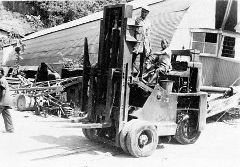 equipment for just one million Dutch guilders. After the Americans leave, Hollandia consists of four main areas:
equipment for just one million Dutch guilders. After the Americans leave, Hollandia consists of four main areas:
The airport and the plains around Lake Sentani;
The town of Kota Baru ( Inner Hollandia) later Hollandia City and currently Abepura;
The harbour with Dok 5 ( Nordwijk later on) for European residents, Dok 2 and Dok 8, a military camp and a marine base;
Ifar 17km away from the town
( Previously the camp for the Seventh Fleet).
Over 2000 disciplined Japanese prisoner of war are used as labourers for all the activities instigated by the Allied Forces to improve the infrastructure, but on 9 June 1946 they receive notice that the POWs need to be returned home. A few weeks later, 800 Macassar* workers are brought in as reinforcement and they are contracted to stay until the end of 1946.
* (Capital of the island of Celebes, today known as Sulawesi Selatan)
9. NICA governs liberated area
The governance over liberated West New Guinea is exercised by the NCIA 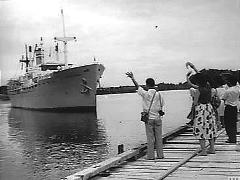 (Netherlands Indies Civil Administration), which arrived along with the American Army when it first landed in 1944. Although entirely dependent on this army, it functions as a separate entity. After some kafuffle, it is assigned a permanent place in Jabau Valley, in the Assee village area. On this spot, located between Lake Sentani and Abepura, NCIA sets up its own village, Kota Nica. Here the Netherlands Indies administration has its office, a hospital, barracks, a school, a small church and a passanggrahan ( a government guest house). The Papua Batallion ‘Hulptroepen’(assistant unit) is put up at the hostel. In September1945 Papua
(Netherlands Indies Civil Administration), which arrived along with the American Army when it first landed in 1944. Although entirely dependent on this army, it functions as a separate entity. After some kafuffle, it is assigned a permanent place in Jabau Valley, in the Assee village area. On this spot, located between Lake Sentani and Abepura, NCIA sets up its own village, Kota Nica. Here the Netherlands Indies administration has its office, a hospital, barracks, a school, a small church and a passanggrahan ( a government guest house). The Papua Batallion ‘Hulptroepen’(assistant unit) is put up at the hostel. In September1945 Papua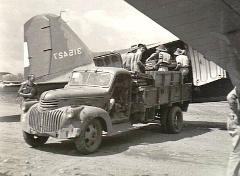 Leaders request that the Netherlands help develop their move towards independence.
Leaders request that the Netherlands help develop their move towards independence.
Kota Nica is demolished in 1946, after all equipment and service buildings are transferred to Hollandia City. But for the concrete terraces, nothing remains of the former establishment. Years later in 1952, an Argriculture Research Station is set up in this particular valley.
10. Massive distribution and rebuilding
In 1947, the Engineers Office ‘Ingeneren-Vrijburg NV’ is to monitor the ‘Management and Liquidation of Resources’. It is clear that an inventory needs to be made of the property left behind and that this needs to be distributed to the islands of the Archipelago, where the need is most pressing. A lot is shipped off to Indonesia for rebuilding it after the war. Almost everything is there in abundance: food, clothing, other textiles, pharmaceuticals, toiletries, crockery and cutlery.
A Dutch team of technicians begins on the overhaul of heavy equipment, bridges, jetties and the maintenance of electricity and water supplies, homes and vehicles. This team also constructs the Bernhard Bridge, made of steal. Recruitment of labourers is done on the Tanimbar Islands and Timor. A proposal is made to bring in collaborators from the Netherlands and put them to work in New Guinea to dismantle American bases and clean up equipment left behind at the end of World War II. Beginning in 1947, the first group of 119 collaborators, NSB members (Nationalistic Socialist Bond), arrive on Biak and a second group of a similar size arrives in Hollandia in March of 1948. On 1 October 1949, they all get an honourable discharge and the Foundation Management and Liquidation of Resources is dissolved.
11.The final years of Dutch Rule:1949-1962
After 1949, when the handover of the Dutch East Indies has occurred on 27 December, the situation in Holandia starts to deteriorate. The American supplies have been taken to Indonesia and not much is left behind.
From 27 December 1949 to 1 April 1953, Stephen van Waardenburg is the Governor of West New Guinea and lives in the ‘palace’ in Hollandia City. From 1950 onwards, many young bachelors from Java come to Hollandia. They are the DETA Boys (Economic and Technical Service Team) who have a government contract of a year to help improve the infrastructure in New Guinea. They were a rough and ready, but welcome labour force.
Van Waardenburg is succeeded by Jan Van Baal, previously director the Native Affairs Office. Van Baal stresses the importance of Applied Anthropology in developing the country. This supports the policy of the Dutch Government to prepare New Guinea for independence. On 1 April 1958, Pieter Platteel becomes the last Governor of Dutch New Guinea. He leaves this country on 28September 1962. The governance is now taken over by the United Nations.
During the fifties, Australians arrive to clean up, buy and ship out materials dumped in the war, including air and ship wrecks, some of which had been sunk.
After 1949, Dutch Churches begin converting Papuans in areas around Hollandia. In April 1951, a catholic secondary school is set up in Dok 5. After the hand-over to Indonesia in 1963, the school is renamed as Sekolah Menengah Atas (SMA) and later on still it becomes Sekolah Menigah Unum(SMU). In December 1951, a seminary is founded in Hollandia which later becomes a theological college known as ‘Fajar Timur’.
12. The new regime Indonesia
After transferring New Guinea to the United Nations on 1 October l 1962, Hallandia gets an Indonesain name Kota Baru (New City). It retains this name until Indonesia takes over New Guinea on 1 May 1963 when the country officially becomes the 27th province. Humboldt Bay gets the name Tuluk Yos Sudarso. Most of the Dutchleave and because of the Indonesian Transmigration Policy the city is populated with people from Java, Sumatra and Sulawesi, making the Papuans a minority in their own territory.
Up until the end of 1968, Sukarno has the city called after himself and it becomes known as Sukarnopura after which it gets its current name of Jayapura (Djajapura and Jaya Pura are earlier spelling versions). The city is split into two districts: North and South Jayapura .In 2008 it had almost 40.000 inhabitants,but in reality this figure is probably higher because of the weekly influxes of people from other parts of the country.
Jayapura, translated from Sanskriet means ‘city of victory’.
13. Links
Also on this website, a theme page on World War II in New Guinea and another on Collaborators in New Guinea
- Maps of Hollandia and the surrounding areas, one of which ‘50 Jaar Hollandia 7 Maart 1960’
- School maps of Hollandia region
( Scale1:50.000)
14. Sources
- F.J. Nieuwenhuijs-Schuurman, Ons verblijf in Hollandia in de ‘Basistijd’, december 2007 Apeldoorn
- Ingenieursbureau Ingenegeren-Vrijburg NV, Holland in Hollandia, 1948 ‘s Gravenhage
- Dr.K.W.Galis en H.J. van Doornik, 50 jaar Hollandia; 7-3-1910 / 7-3-1960, 1960 Hollandia
-N.A. van Balgooy, R.A.Tomasouw en F. Snackey, DETA contractanten. Gedenkboek ter gelegenheid van ons 12-jarig verblijf in Nieuw-Guinea 1950-1962, 1998
- John Vader, Nieuw-Guinea, het keren van het tij, 1978, Standaard Uitgeverij NV Antwerpen
- Comments and Advice: Nancy Jouwe